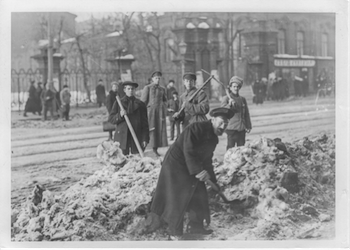

|
Revolution and Revenge  Putting a 'burzhooi' to work There was no popular reaction against the dissolution of the assembly. The peasantry, who had supported the SRs, saw the Constituent Assembly as a symbol of 'the revolution' but it was only a distant thing in the city, whereas they had their own village Soviets which carried out the revolution on the land. Through their village Soviets they divided the gentry's land and property among themselves. They did so in line with their own egalitarian norms of and did not need the sanction of the Bolshevik Decree on Land (no central power could control what they did). In provincial towns and cities the Soviets passed into the hands of the Bolsheviks and Left SRs either through the ballot box or with the help of the local garrison in street fighting. The establishment of Soviet power was often accompanied by the looting of 'bourgeois' property. Lenin encouraged local Bolshevik leaders to organize the 'looting of the looters' as a form of social justice by revenge. Soviet officials, bearing flimsy warrants, would go round bourgeois houses confiscating typewriters, furniture, clothes and valuables 'for the revolution'. The Soviets levied punitive taxes on the bourgeoisie and imprisoned hostages to force payment. Thus began the Bolshevik Terror. Retribution and revenge were powerful revolutionary impulses. For the vast majority of the Russian people the ending of all social privilege was the basic principle of the revolution. By giving institutional form to this war on privilege, the Bolsheviks were able to draw on the revolutionary energies of those numerous elements from the poor who derived pleasure from seeing the rich and mighty, the 'buzrhooi', destroyed, regardless of whether it brought about any improvement in in their own lot. |
© 2014 Orlando Figes | All Rights Reserved